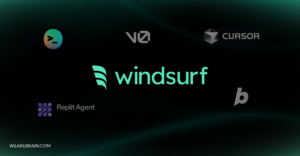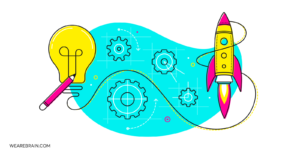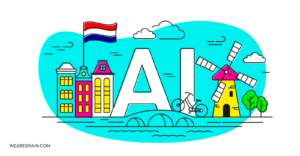Top AI frameworks and machine learning libraries

Looking for a conclusive guide to artificial intelligence, automation and their applications? WeAreBrain’s new book, Working Machines – An Executive’s Guide to AI and Intelligent Automation, takes a comprehensive look at this incredible technology in an easy-to-understand non-techie way. Purchase it from Amazon, Google Books, Apple Books or Audible.
The AI and machine learning landscape continues to evolve at breakneck speed. Whether you’re a seasoned developer, a curious data scientist, or a business looking to leverage AI capabilities, staying current with the best tools is essential for innovation and efficiency.
As artificial intelligence becomes increasingly integrated into business operations across industries, selecting the right AI frameworks and machine learning libraries is more critical than ever. The wrong choice can lead to development bottlenecks, scalability issues, or suboptimal performance—factors that directly impact your project’s success.
In this comprehensive guide, we explore the most relevant AI frameworks and machine learning libraries for 2025, helping you navigate the increasingly complex ecosystem of AI technologies. We’ll examine their unique capabilities, ideal use cases, and how they fit into the broader machine learning ecosystem.
Whether you’re building a recommendation system, implementing computer vision functionality, or developing natural language processing solutions, this analysis will help you make informed decisions about your AI technology stack.
1. TensorFlow: Google’s versatile AI framework
Developed by Google, TensorFlow remains a cornerstone for deep learning in 2025. Its versatility shines in building and training neural networks for tasks ranging from image classification to natural language processing.
What makes it stand out:
- High-level APIs like Keras for simplified model building
- GPU acceleration for handling massive datasets efficiently
- Deployment capabilities for production environments
- Latest updates include NumPy 2.0 support and Hermetic CUDA for reproducible builds
TensorFlow’s combination of accessibility and scalability makes it equally valuable for research projects and enterprise applications.
2. PyTorch: Facebook’s dynamic machine learning library
Facebook’s PyTorch continues to dominate in research environments, thanks to its intuitive design and flexibility. Its dynamic computation graph gives developers the freedom to modify models on the fly, making debugging and experimentation significantly more accessible.
Key strengths:
- Dynamic computation graph for flexible model building
- Extensive ecosystem of pre-trained models
- Just-in-time compilation for optimised performance
- Gaining significant traction in generative AI applications
PyTorch’s balance of power and usability has cemented its position as a favourite among researchers and developers working on cutting-edge AI applications.
3. JAX: Advanced numerical computing for AI research
Another Google project, JAX, has seen remarkable growth as a numerical computing library specifically designed for machine learning research. Its functional programming approach represents a shift in how developers think about computation.
Standout features:
- Just-in-time compilation for lightning-fast performance
- Seamless NumPy integration for accessibility
- Optimised for complex computations and parallel processing
- Particularly useful for optimisation problems
JAX is increasingly the go-to choice for researchers pushing the boundaries of what’s possible in machine learning computation.
4. scikit-learn: Python’s essential machine learning toolkit
With over 22 million downloads per month, scikit-learn remains the trusted companion for traditional machine learning tasks. Its consistent API and extensive documentation make it the first choice for many data scientists working on classification, regression, and clustering problems.
Why it’s essential:
- Comprehensive suite of algorithms for data mining and analysis
- Consistent interface across different models
- Extensive documentation and community support
- Often paired with deep learning frameworks for feature engineering
Even as deep learning dominates headlines, scikit-learn’s importance for everyday machine learning tasks cannot be overstated.
5. XGBoost: High-performance gradient boosting library
Known for dominating data science competitions, XGBoost continues to deliver exceptional performance for gradient boosting applications. Its speed and efficiency with large datasets make it particularly valuable for businesses working with complex datasets.
What sets it apart:
- Optimised for speed and performance
- Built-in regularisation techniques to prevent overfitting
- Includes cross-validation capabilities
- Parallel tree boosting for enhanced performance
XGBoost remains the first choice for many data scientists tackling structured data problems where performance is critical.
6. LightGBM: Microsoft’s memory-efficient ML solution
Microsoft’s LightGBM has carved out its niche as a memory-efficient gradient boosting framework. Its ability to handle high-dimensional data without consuming excessive resources makes it particularly valuable for enterprise applications.
Key advantages:
- Exceptional speed and memory efficiency
- Native support for categorical features
- GPU acceleration for performance boost
- Well-suited for distributed systems
For teams working with limited computational resources or massive datasets, LightGBM offers an elegant solution that doesn’t compromise on performance.
7. CatBoost: Categorical data specialist for machine learning
Developed by Yandex, CatBoost excels in handling categorical data without extensive preprocessing. This capability alone can save significant development time and reduce potential sources of error in the machine learning pipeline.
Notable strengths:
- Superior handling of categorical variables
- High accuracy and speed
- Support for distributed training
- GPU acceleration capabilities
CatBoost’s specialisation in categorical data has made it increasingly popular in industries like finance and e-commerce, where categorical features are abundant.
8. Hugging Face Transformers: State-of-the-art NLP framework
The Hugging Face Transformers library has revolutionised natural language processing by making state-of-the-art models accessible to the broader developer community. Its pre-trained models have democratised advanced NLP capabilities.
Why it’s transformative:
- Pre-trained models for text classification, translation, and more
- Simple API for fine-tuning on specific tasks
- Support for multiple frameworks (TensorFlow, PyTorch, JAX)
- Backed by a vibrant community of contributors
For anyone working with text data, Hugging Face Transformers offers a shortcut to implementing sophisticated language understanding capabilities.
9. OpenCV: Leading computer vision AI library
Computer vision continues to drive innovation across industries, and OpenCV remains the definitive library for image and video processing tasks. Its real-time processing capabilities make it essential for robotics and augmented reality applications.
Key capabilities:
- Comprehensive tools for image and video analysis
- Feature detection and object recognition
- Cross-platform compatibility
- Real-time processing optimisations
From autonomous vehicles to medical imaging, OpenCV provides the building blocks for computer vision applications that interact with the physical world.
10. AI Fairness 360: Ethical AI development framework
As AI systems increasingly impact critical decisions, ensuring fairness has become a priority. IBM’s AI Fairness 360 toolkit addresses this need by providing resources to detect and mitigate bias in machine learning models.
Important features:
- Metrics for assessing bias in AI systems
- Algorithms for mitigating unfairness
- Integration with popular machine learning frameworks
- Tools for ensuring ethical AI development
The inclusion of AI Fairness 360 reflects the growing emphasis on responsible AI development—a trend that will only become more significant as AI applications continue to expand.
Choosing the right machine learning tools
The AI landscape in 2025 reveals both evolution and continuity. Established frameworks like TensorFlow and PyTorch maintain their dominance, while specialized libraries like Hugging Face Transformers and JAX gain traction for specific tasks. The rise of ethical AI tools reflects the industry’s growing responsibility as these technologies become more integrated into daily life.
For developers and organizations, choosing the right machine learning toolkit has profound implications for project success. The right framework can accelerate development, improve model performance, and ensure scalability as your applications grow.
Need help navigating these AI technologies for your business? Get in touch. Our AI development and consulting team can discuss how we can help implement custom AI solutions tailored to your specific challenges, using the most appropriate frameworks and libraries.
Dmitry Ermakov
Working Machines
An executive’s guide to AI and Intelligent Automation. Working Machines takes a look at how the renewed vigour for the development of Artificial Intelligence and Intelligent Automation technology has begun to change how businesses operate.







